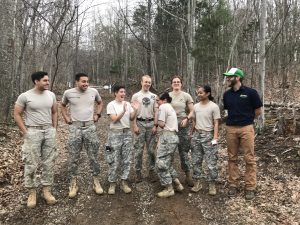
Virginia Military Institute Cadets Give Back at VOF’s House Mountain Reserve
Cadets help to clear a section of trail at the 875-acre reserve as part of their spring field training exercises.
VOF Reserves
Rockbridge County
House Mountain’s distinctive profile serves as the backdrop to Lexington. The 884-acre reserve is located in the Ridge and Valley Province of Virginia and sits on the western edge of a limestone valley. The topography is generally steep mountainous terrain, but also encompasses the gentle saddle area—a meadow once planted as an orchard. The saddle sits between the twin peaks of Big House Mountain (3,645 ft.) and Little House Mountain (3,386 ft.). The peaks are sandstone with underlying shale, which acts as an impervious layer creating what is known as a perched water table. This geological feature causes many springs to originate on the property, including the headwaters of Sugar Creek, Whistle Creek, and Colliers Creek.
The slopes of House Mountain were settled with homesteads in the latter part of 19th century and used primarily for agricultural purposes at surprisingly high elevations. The predominate tree species now are black oak (Quercus velutina), scarlet oak (Quercus coccinea), chestnut oak (Quercus montana), tulip poplar (Liriodendrun tulipifera), hickory (Carya spp.), and various pine. There are significant stands of rhododendron (Rhododendron maximum) and mountain laurel (Kalmia latifolia), as well as stands of table mountain pine (Pinus pungens). There are also saplings of American chestnut (Castanea dentata) sprouting from stumps of this once prolific tree. All major game animals are present—deer, bear, wild turkey, ruffed grouse, raccoon, squirrel, and rabbit.861
House Mountain has historically been used and enjoyed by the residents of Lexington and Rockbridge County for recreational purposes including hiking, non-motorized mountain bikes, hunting, and primitive camping, as well as for scientific and educational activities. Both the Virginia Military Institute and Washington & Lee University have annual traditions involving the use of the property.
The Rockbridge Area Conservation Council initiated the House Mountain conservation project in 1988 when the property was put up for sale by its owner, White’s Truck Stop. Locals feared the property would be acquired by developers, and they considered its preservation as open space a top priority. The purchase price at the time was $325,000. The Lexington community, with Rockbridge Conservation Council organizing, raised approximately $150,000 in funds, which were donated to the Virginia Outdoors Foundation for the project. The Virginia Outdoors Foundation contributed an additional $175,000 toward the purchase of the property and acquired ownership on July 5, 1989, thus ensuring the landmark and its natural resources would be forever conserved as public land and available for public enjoyment.
Go west out of Lexington on Route 60 (Midland Trail) about 2 miles, then turn left on Jacktown Road (Route 641). Go about 3.5 miles, then turn right on Saddle Ridge Road (Route. 643). There is a parking lot for House Mountain on the left before the end of state maintenance. Look for a parking sign. The parking lot includes a kiosk with a map showing trails and rules.
Motorized vehicles are prohibited.
Respect the rights of adjoining property owners and other visitors.
THIS IS A PRIMITIVE AREA. There are no restrooms or visitor facilities.
Hiking, mountain biking, horseback riding, lawful hunting, and primitive camping are permitted.
Scientific inquiry and educational programs are permitted. Requests to conduct research on the property or plan organized group programs should be directed to VOF with plenty of advance notice.
Manage Your Waste Properly
Visitors must be aware that this property is available for hunting. Please take caution and wear blaze orange. Hunters must have a valid license and follow all applicable laws and regulations. To report hunting violations: (800) 237-5712 or wildcrime@dgif.virginia.gov.
If you would like to plan an organized group trip or visit to this reserve for educational, research, or scientific purposes, please contact Leslie Grayson at (703) 850-3924.

Cadets help to clear a section of trail at the 875-acre reserve as part of their spring field training exercises.